JBL LSR308 Review
This review has been a long time coming. I've had these on the back burner for a year, unsure if they were the greatest budget speaker ever, or just a colossal failure in material design. The truth ended up somewhere in the middle.

These speakers are big... you can almost fit three of the smaller JBL LSR305's inside of the volume of one of the 308's. This is stupid massive for a desktop, especially for my little office, so this review is more focused on living room performance.
Some background information:
Here is a little perspective as to why this review is important. There is an entire audiophile faction that believes in limited dispersion controlled directivity speakers. The goal for this group is for speakers to have is limited interaction with the room. In my experience this will give you more of a feeling of being taken to the place where the music was recorded instead of the recording taking place in your room. As someone who likes studio recordings for their perfection, and hates most live recordings for their flaws and background noise I don't have much interest in speakers designed with this goal. My reference system has a ridiculously wide dispersion.
The thing here that makes this relevant is that the JBL LSR308 on paper is damn near as good at controlled directivity as anything else on the market. The way to measure controlled directivity is with polar measurements. This is basically a series of frequency response measurements, walking the measurement mic around the speaker to see how much the volume decreases as you go off axis. A good result will show a smooth uniform drop off as quickly as possible. Here is a polar response measurement of the JBL LSR308's taken by Dr. Earl Geddes, a man with some serious audio chops, shown in the program that he wrote for displaying these measurements.
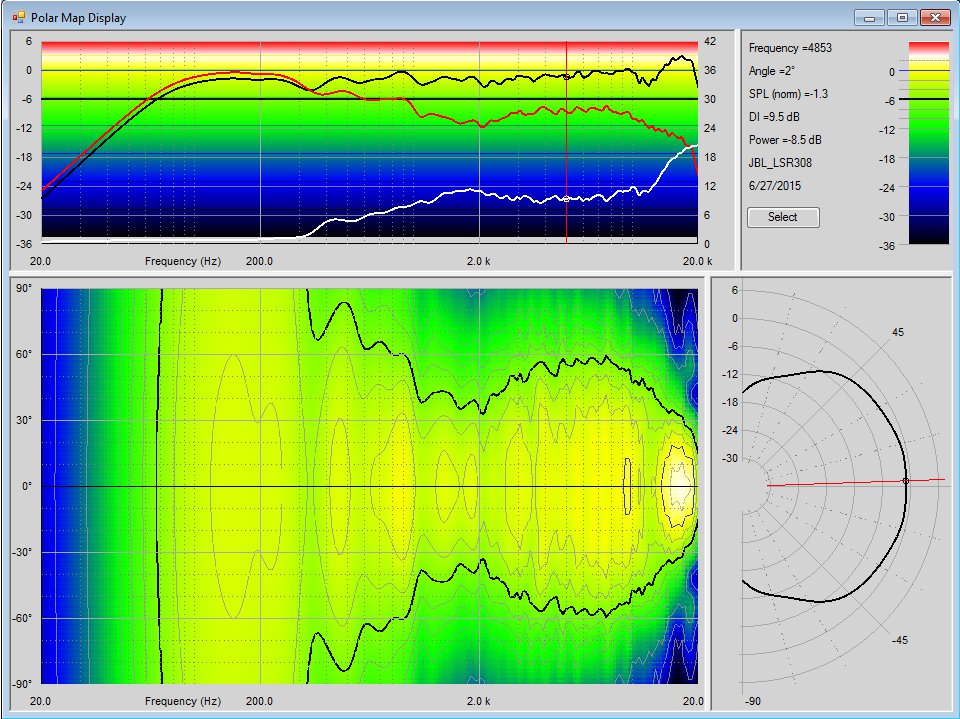
To quote the good doctor, "For $200 that is an amazing speaker. There are of course better speakers, but at $200 I don't think ever I've seen a better speaker." To clarify, that $200 number is the average price for each speaker, and pair will cost you double.
All of that to me is icing on the cake. I picked up the speakers because I was hopeful that they would provide full range audio for cheap. The JBL LSR305's are currently the cheapest naturally good sounding speakers you can buy. Those speakers are smaller, don't play as loud, and because they are smaller they do not have the pattern control that is possible with a larger speaker. They also don't play as deep, or with as much authority as a larger speaker.
The LSR308 is speced to play flat down to 37Hz. That's plenty for most music, and unlike other manufacturers JBL Professional does not bullshit it's specs.
The LSR305 does 43Hz, which is very deep for a little speaker, but as I noted in my review they stumble when asked to perform at volumes needed when partying in larger rooms.
So now that you have that bit of background info, you can see there was a lot of hype and hope for this speaker.
Components:
Waveguide Tweeter
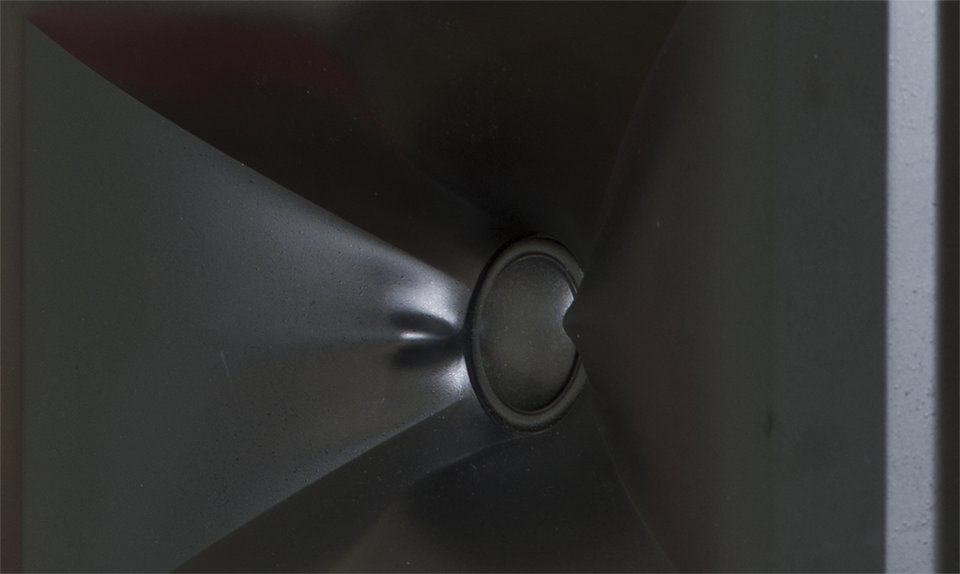
The waveguide design is pulled from the flagship JBL M2 system, while using a small button magnet soft dome tweeter instead of a compression driver. The larger the waveguide the more directivity control at lower frequencies. This waveguide is pretty big, and should control horizontal directivity down to about 2500Hz.
Woofer
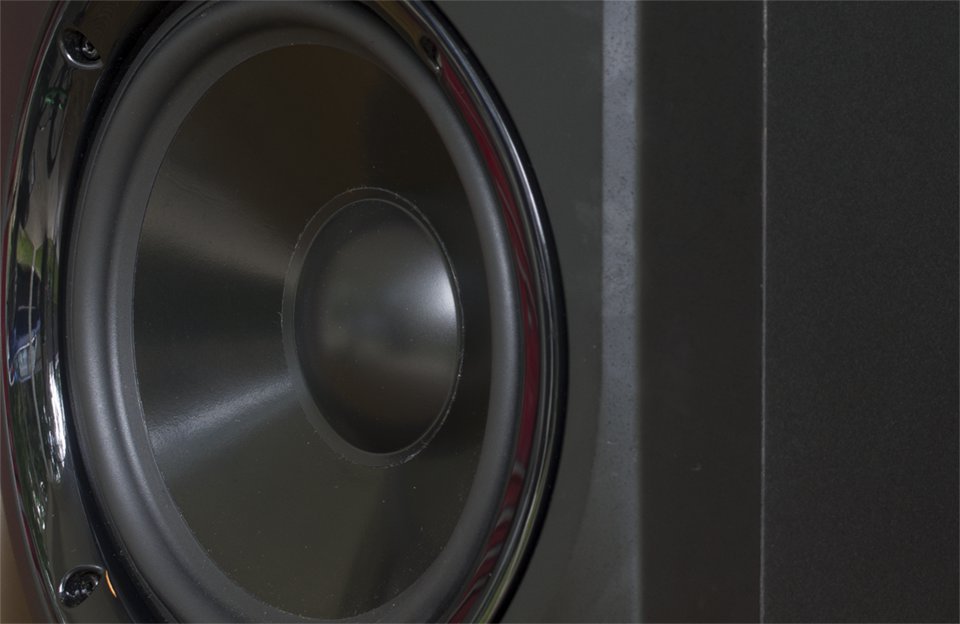
Look at all of those inches, 8 to be exact. The cone material is some type of polymer-coated aluminum or some such. I think it's the same material that Infinity uses on it's Primus line of speakers.
The butyl rubber surround insures a long life, and isn't overly stiff.
Like all Harmon speakers I've reviewed this woofer has a backing magnet.
I did figure out that this is for more than magnetic shielding, it also increases the BL of the driver. The higher BL means that the driver has a higher acceleration, getting where it needs to go fast with the extra little magnet.
Plate Amp
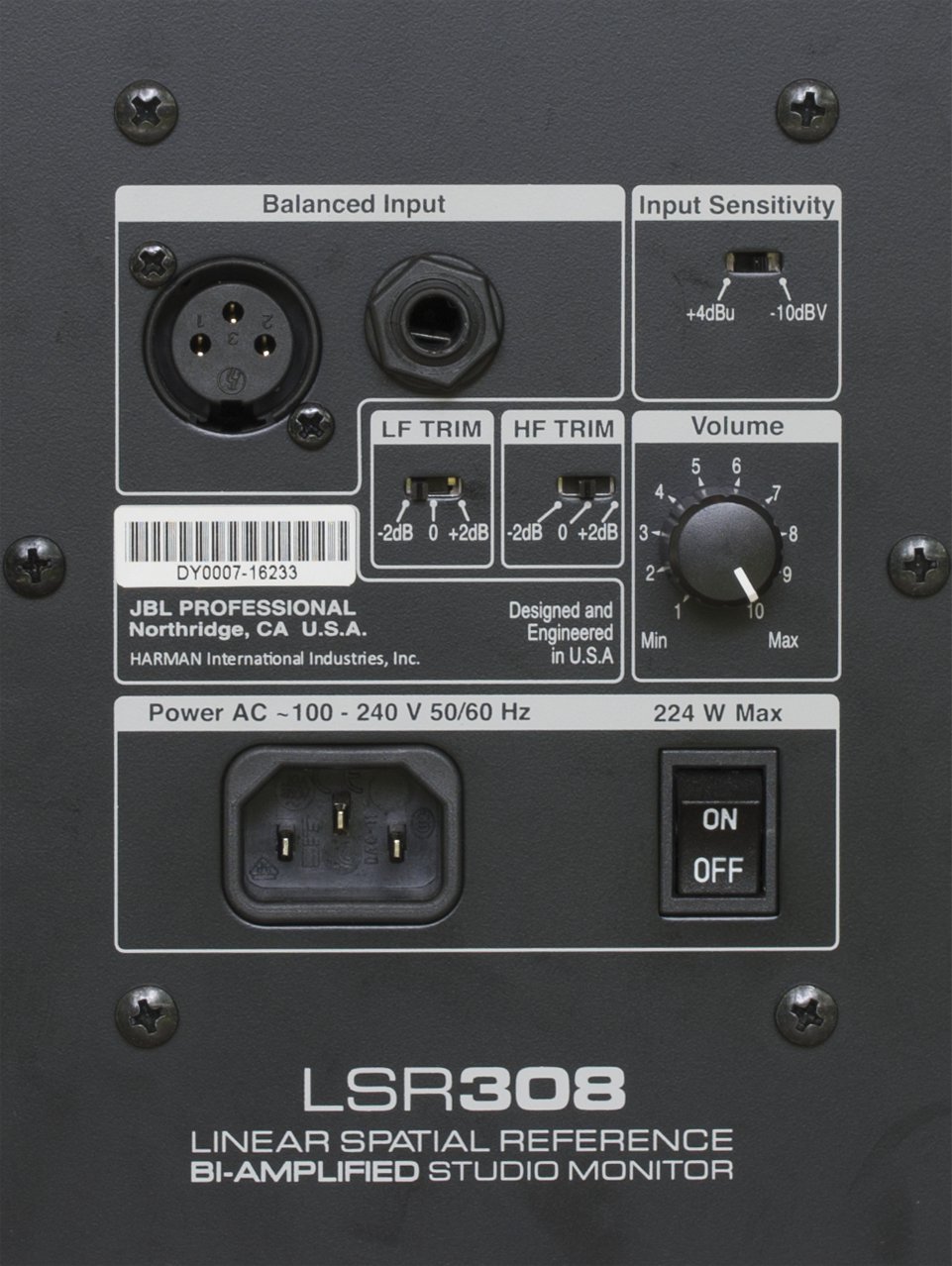
The plate amp take up the entire back of the speaker. It's a massive yet very thin piece of sheet metal with a tiny amp screwed to the middle of it. The Amp itself has lots of watts. It's a Class D amp that puts out 56watts for the tweeter, and 56 watts for the woofer. I did get a bit of hiss using only unbalanced consumer grade sources and the gain turned all the way up, but it wasn't too bad with the speakers a few feet away.
Cabinet
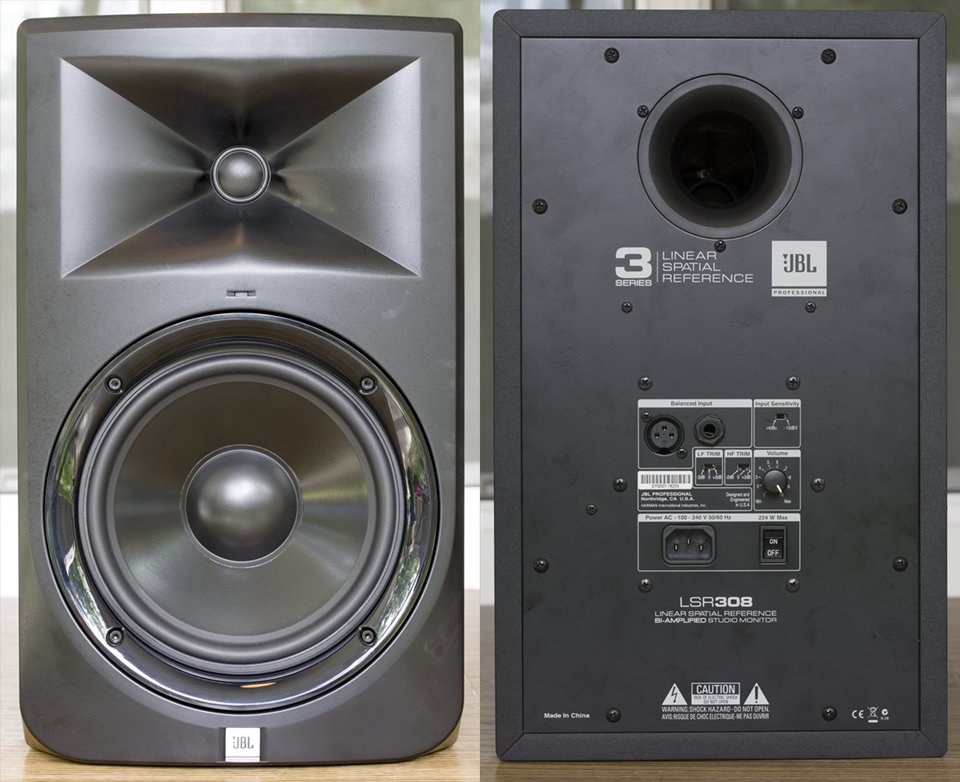
The cabinet is a box without a front or a back, it's pretty good thickness MDF, but no bracing inside at all. Giving the side a knuckle wrap will leave you feeling hollow and unsatisfied.
The 1/8 inch thick plastic front baffle and 1/16 inch thick unbraced metal back plate makes this the worst cabinet I've ever seen from a material selection stand point.
The back panel flexes quite a bit when inserting the power plug or 1/4 inch jack. The wave guide is at least a very stiff structure, but tapping on the waveguide you can feel the lack of material behind it.
I wish JBL would have talked to the Infinity Primus team about cabinet construction and gone for a little more beef or bracing.
Port
It's got a port on the rear of the speaker, which is comically mounted to the sheet metal back. The port itself is not too deep, and pretty wide. More than any speaker I've tested so far these speaker need to be away from back walls, if that can't happen then you need to flip the -2dB switch on the back of the speaker to drop the bass response as it can easily smother the midrange.
Office Setup Listening Notes:
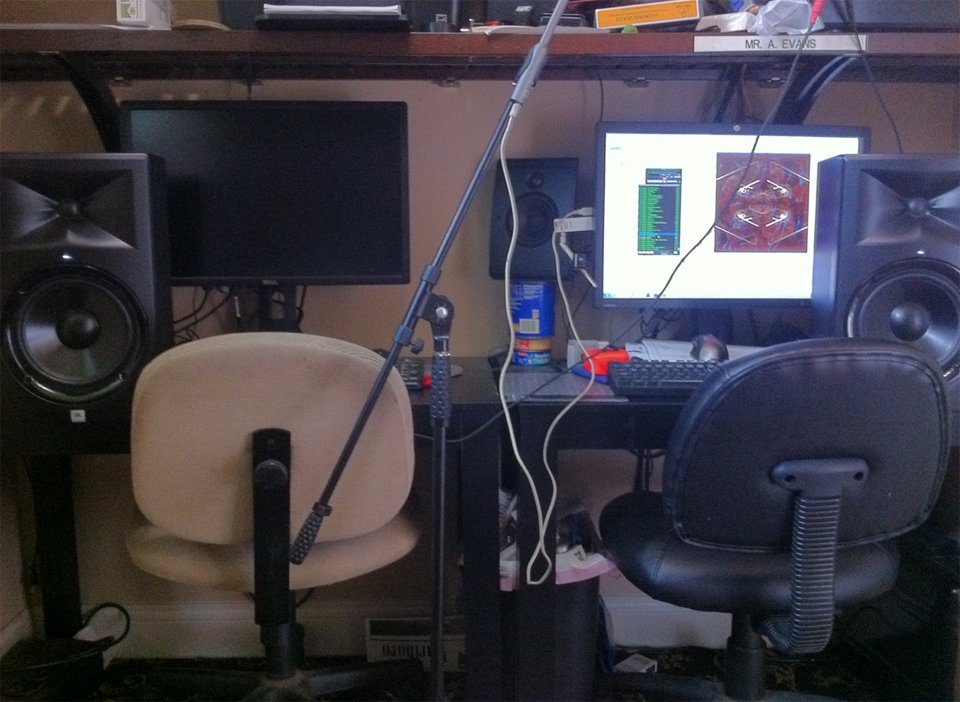
I had the 308's in my little 7 x 11 foot office initially and they just over powered the room with too many bass, and not enough placement options to get anything right. Here are some of the notes I took from those sessions.
Fall apart before they get loud. Scrambled like they are too big for the room, directivity can't fix the stupidity of putting these speakers in this tiny room.
I keep checking the SPL meter and it's only reading out 85dB but it's just full of music, losing definition.
The exceptions are the audiophile fare of music where its one or two instruments playing. If the music is not busy they excel like nothing in this price range should.
There seem to be problems with the top octave sounding hot. Also, the speakers can sound like they are yelling at the listener, which is something I find true with all horn/waveguide speakers.
Serious bass, but you will not be wondering where the subwoofer is, the source of music is obviously these massive boxes. These sound boomy too me, but most deep playing rear ported stuff does unless its 3 ft from any walls.
These need work, a sweep test shows the back amp panel on one speaker is rattling when 140-200hz is played. JBL said that they built these as cheap as possible, and they were not lying. On the plus side you get the cutting edge of tech for peanuts.
Male vocals are over emphasized too much bass into the 200-400hz range even with the -2db switch flipped.
Does EDM like nobody's business - Simian, Orbital, etc. These can definitely be party speakers.
Living Room Listening Notes:
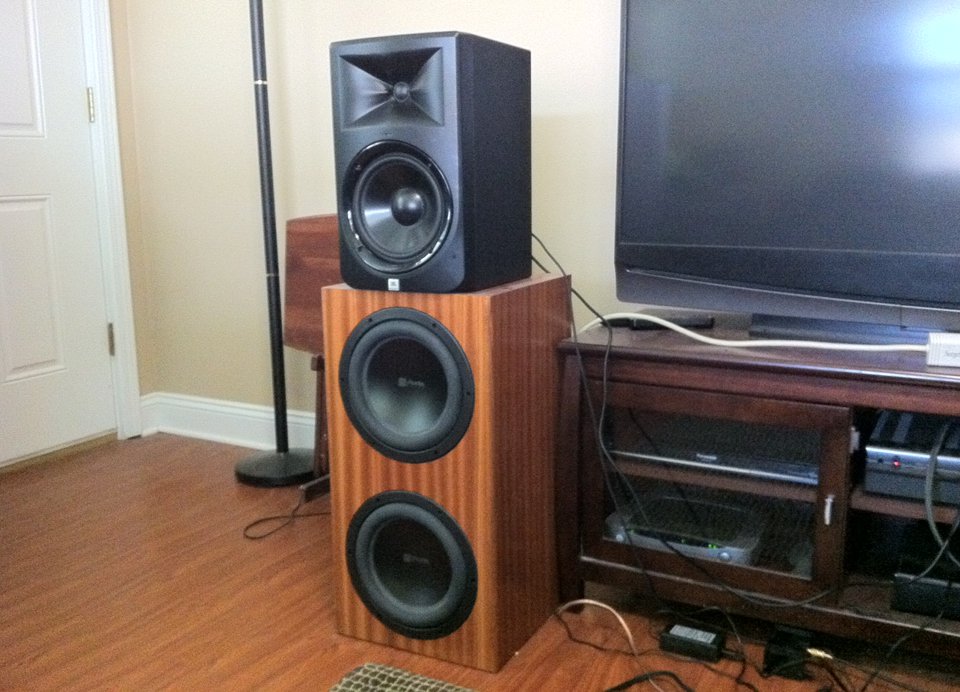
After limited success in the office the JBL LSR308's spent a couple of months in the living room. The wife really appreciated the extra clutter. These were hooked up directly to my Logitech squeezebox as a source and I did not run them with my subwoofers, which were only used as stands.
With the limited horizontal dispersion the speakers felt they were too close to me.
Tone of some lower treble seemed muted, as it's not blasting out of the side of the speakers, but details were plentiful.
Vertical dispersion was excellent compared to my main rigs ribbon tweeters extremely limited vertical range.
Deep bass in this space did not feel defined. It was playing the notes, but felt more like it was pushing air than providing impact.
As the volume crept over background music levels the lower midrange started to fall apart.
Instead of being smothered by bass like in the office it was just not clear at volume.
After some spirited listening the rattle from the left speaker has gotten worse. This is absurd, even for cheap speakers.
I really think that the quality of the cabinet construction, something that I don't think effects the sound near as much as people give it credit for, is actually ruining these speakers.
There is so much right here that having something this simple be this wrong is not just disappointing, it's upsetting.
Measurements:
Back to the office for some measurements.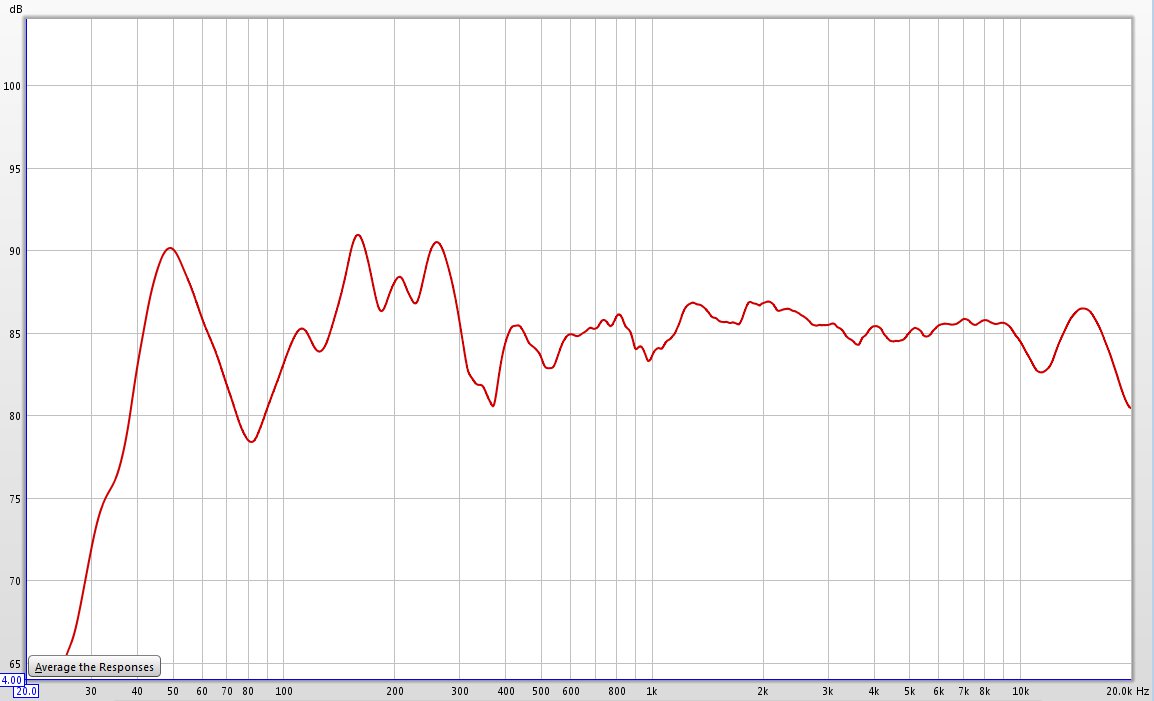
Frequency response looks amazingly flat across the majority of the response. Note that my room modes are wonderfully random in this small room. Anything below 700Hz is more of a indication that the speaker is doing something at those frequencies than an indication of quality.
The top octave(10kHz-20kHz) is very particular to measurements, being off axis just a few millimeters would give a slightly different response.
This is probably a function of the transition from the dome tweeter, to the waveguide.
This is not really audible because human hearing is very shit in this range and +-3dB up there is almost impossible to determine.
The lower midrange and bass are slightly bloated even taking into account the randomness of the room modes. This measurement was done with the bass switched to the 0dB setting. Switching the -2dB setting for bass would have helped even things out.
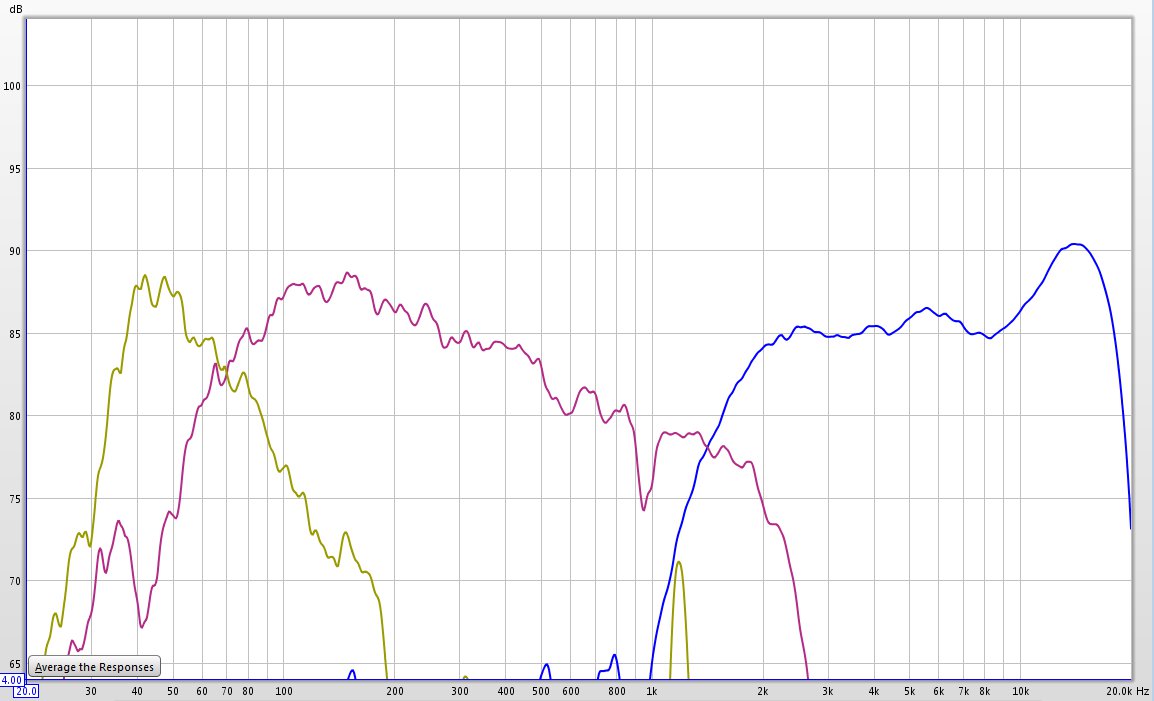
This is the close mic of the drivers, the tweeter is still showing it's ass, and it's still not a big deal. Of note, there is some extra noise coming from the port which indicates internal rattling, but it's not very much.
DSP Correction:
I will usually do a DSP correction for speakers to help them be all they can be. With the JBL LSR308's there is nothing to do here. These speakers tonally are neutral.
The issues that keep this speaker from perfection are classified as "other" and related to the implementation of the design.
If you are limited to close boundary placement and the -2dB bass switch isn't doing the job of freeing up the lower midrange from the boundary gain you can try a 1.0Q filter centered at 250Hz that takes a couple of dB out of the speaker.
Modifications:
The cabinet construction on this speaker is so bad that it must be the problem... so it's arts and crafts time!
Let's talk testicals for a moment. I've got a pair, and they needed to be sized appropriately for the next steps. These speaker's might be cheap, but not that cheap and I was unsure of the results of the very permanent modifications. As such is the case I suggest anyone making these modifications gets blind drunk before they attempt.
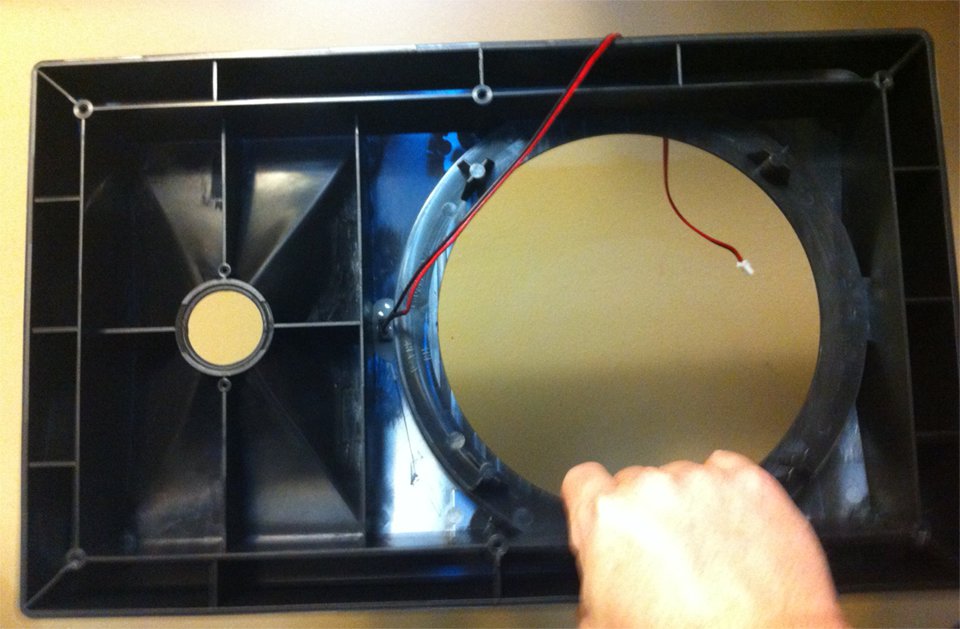
Step one, after drinking a large amount of your preferred booze, is to take the speaker completely apart. First remove the trim ring and woofer, then undue the twist ties that hold the wires to the side of the box. Then flip the speaker over and unscrew the plate amp, remove the connector for the tweeter and front LED wires. Now you can remove the tweeter, and get to work on the six 3 inch long baffle screws that are hidden behind the foam that covers the sides of the box.
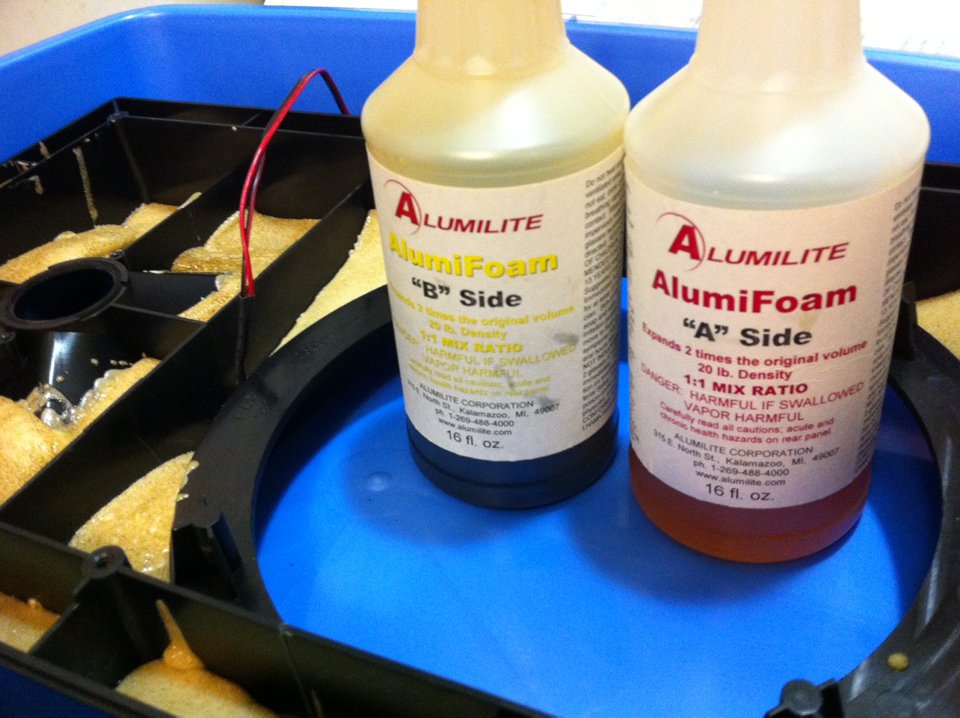
Step two, after procuring some bizarre foam that mimics the density of MDF mix a little bit at a time using a digital scale that the police would call drug paraphernalia. Quickly pour this little bit into one of the dozens of voids on the back of the baffle, being careful not to make a mess, this shit it impossible to get off of the plastic baffle. Oh yeah and you have about 45 seconds to do this from the time that you start mixing, so be quick about it. Repeat anywhere from 25-40 times as needed taking note of the temperature of the baffle, as the foam get retarded hot as it cures and I'm certain it could melt the baffle if a large enough batch was poured at one time.
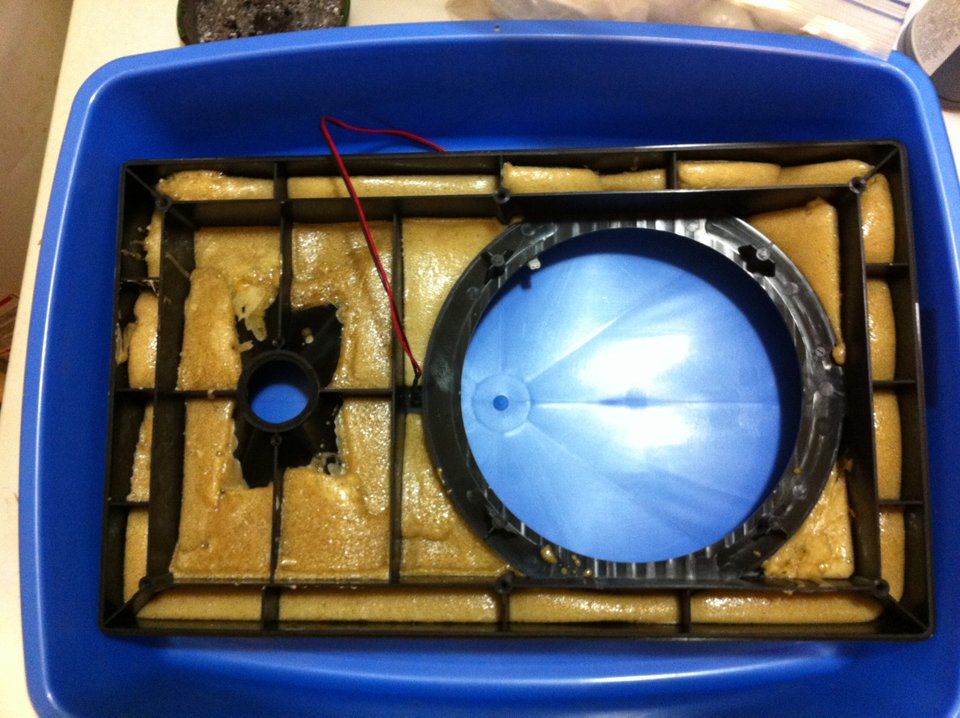
Success! Bask in the glow of the additional 3 pounds of material. The baffle is actually pretty hefty now, and very dead.
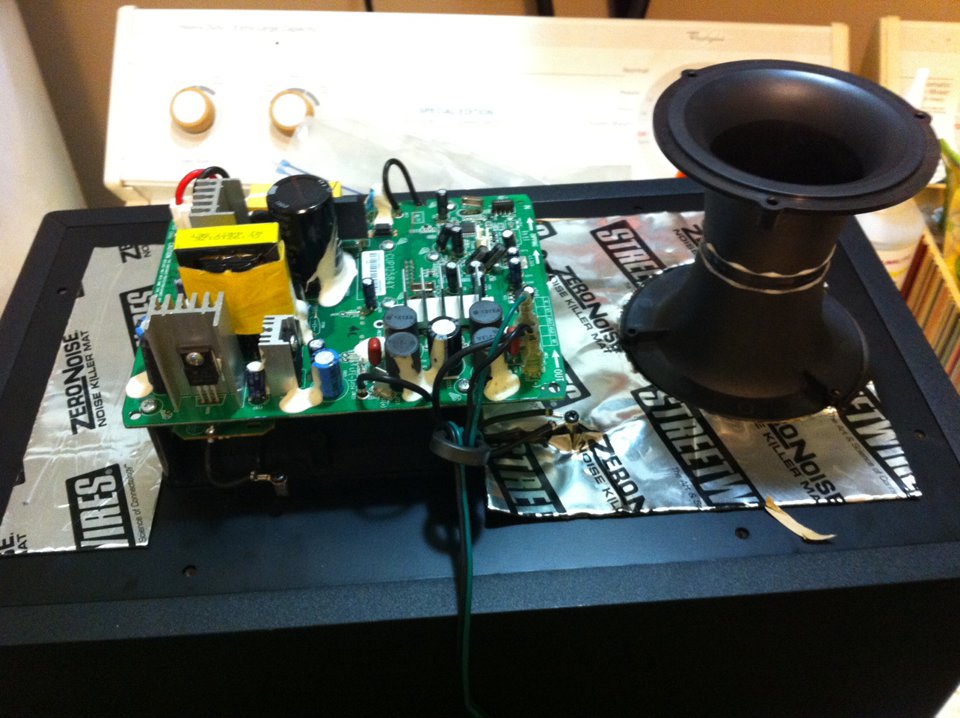
Step three, apply cheap brand-x asphalt backed aluminum onto the sheet metal of the plate amp. Make sure that you cover all surfaces, overlapping seams and scraping the surface down with something like a credit card or putty knife once everything is in place.
Finally, put everything back, except for that wire for the power indicator LED. We don't need that.
Modified Listening Impressions:
After sleeping off the beer and fumes of the curing foam I felt very proud of my now chunky JBL LSR308's. I hauled the speakers back the their perches on my subwoofers and sat down for a listen.
Welp, these sound the same. Same nitpick with the midrange clarity at volume.
No rattle, which is excellent news, but could have been accomplished with an RMA.
Modification Measurements:
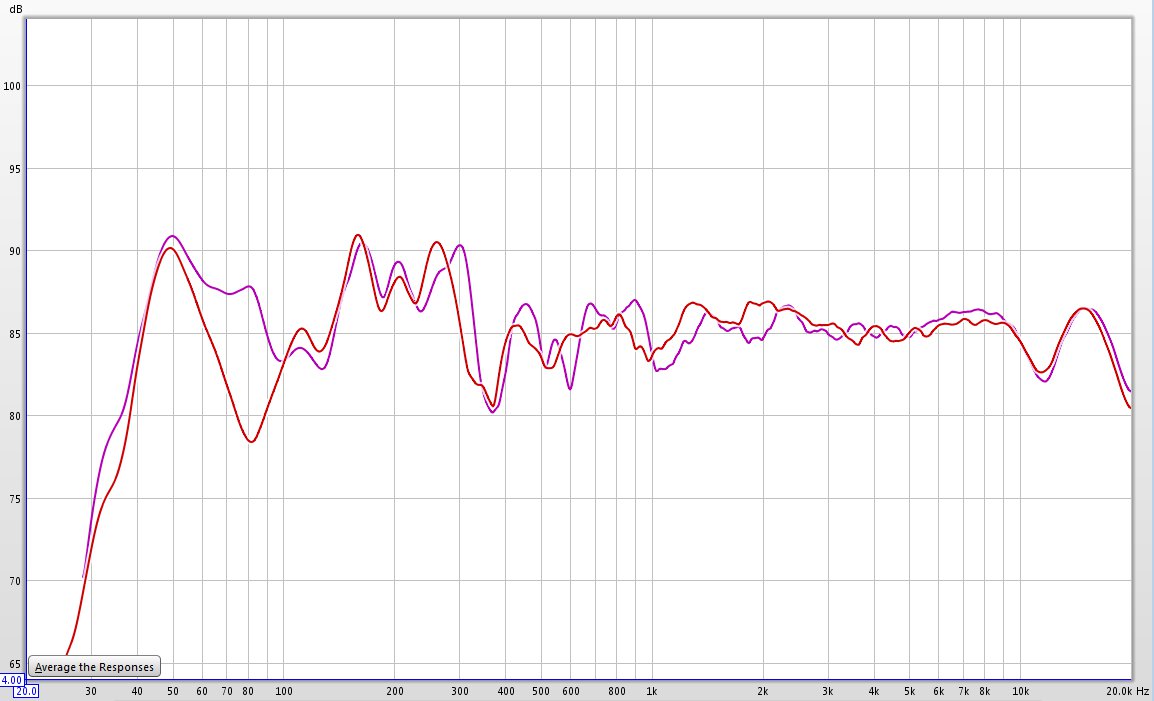
Showing the unmodified and modified measurements side by side - these measurements are closer than most left and right speakers from the same pair.
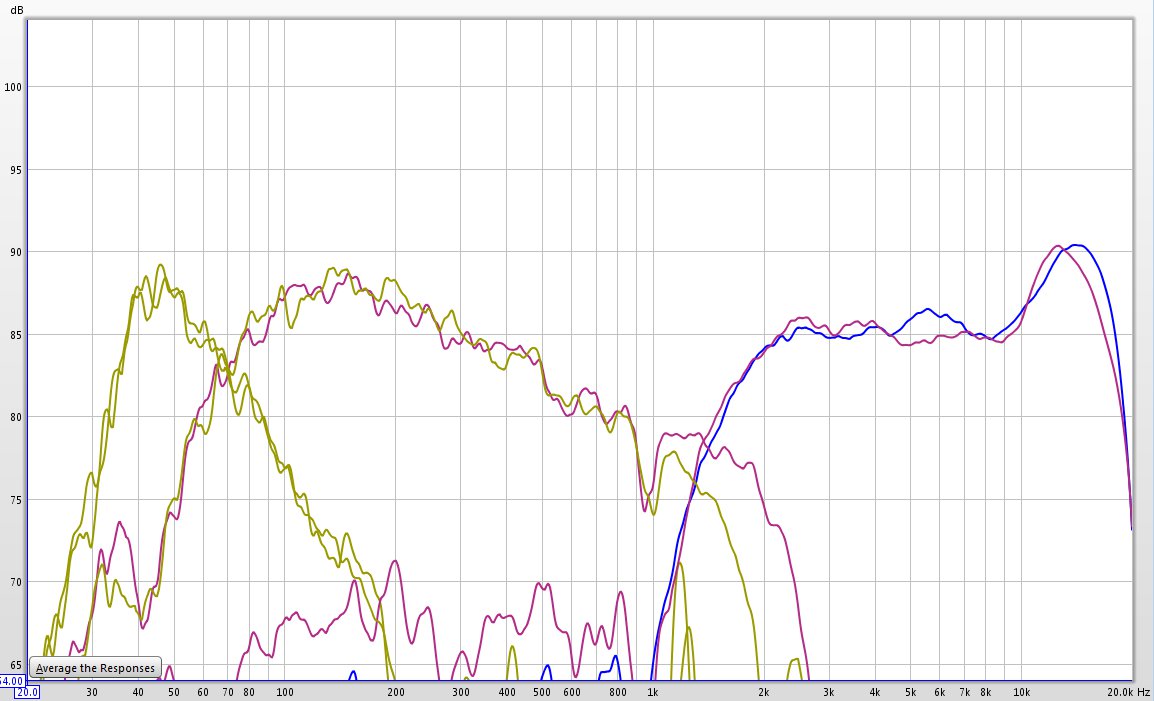
Nothing to see here.
Once more into the Living room
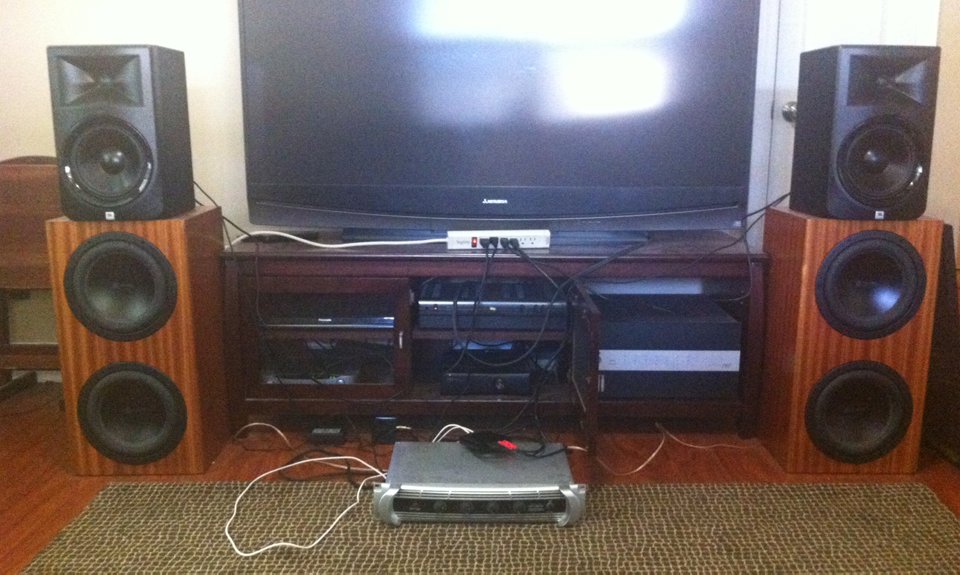
In a last ditch attempt I used brute force to make the speakers better. I crossed the over to my subwoofers.
This is not what I wanted to do here. I wanted great speakers that would be as good as any other at making a broad range of sounds at a consistent volume with clarity.
I wanted something to end the chase. Instead we are left with an expensive fix to an inherent problem on a damn good, but not perfect, speaker.
Crossover duty was performed by a minidsp, and the subwoofers were powered by my Behringer iNuke amp.
I mimicked the crossover found on most A/V receivers - using a first order on the high pass, a second order on the low pass and centered the crossover at 80Hz.
With the low frequencies taken over by the subwoofers, the JBL's sound sublime.
If someone is hunting for controlled/limited dispersion these are the speakers to get. They get loud and stay clean, and they do everything that is asked of them.
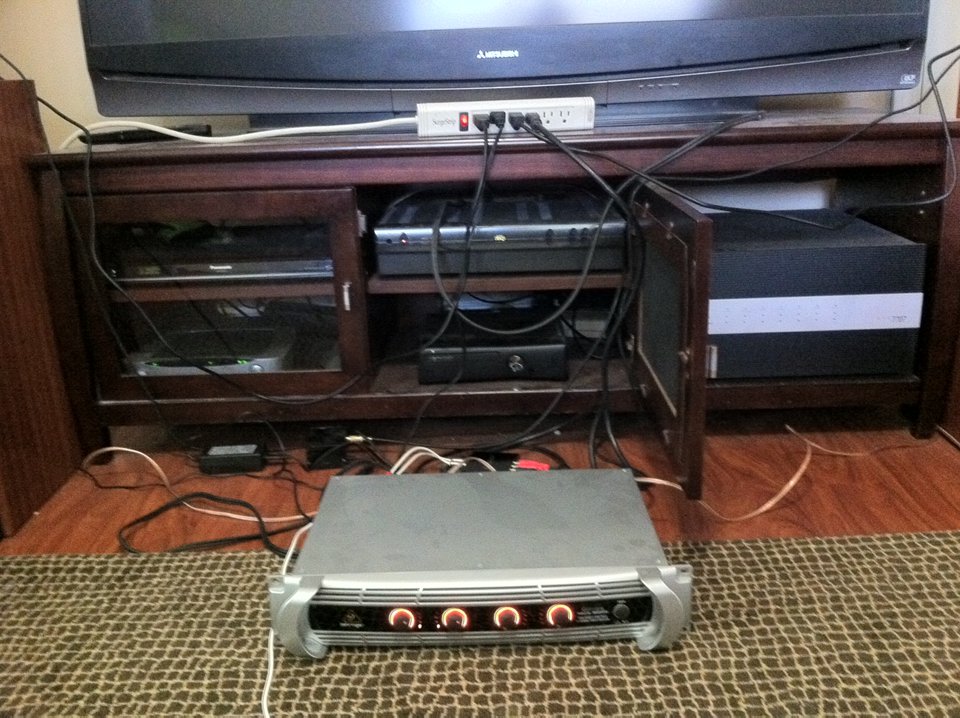
Final Thoughts:
This speaker design asks a lot from the woofer. It's supposed to play clean and flat down to 37Hz, control directivity of the midrange, and crossover cleanly to the tweeter.
I have never heard a two-way speaker that played as clean and deep as a good three-way, and these are no different.
The sensitivity seems to be slightly lower than the LSR305's but these 308's can get a little louder due to the extra power. The clarity and impact of the midbass is excellent using even a rudimentary crossover to a subwoofer.
While these speakers are not everything I had hoped, they are still the best living room speaker I've reviewed.
If you have not heard horn or waveguide speakers and they interest you in the slightest make it a point to pick these up. They are an excellent example of the breed.
Click here to buy JBL LSR308 speakers.
Check out the system finder to see what I recommend.
Other content you may like:
- Vanatoo Transparent One Review - Software update brings new standard of performance!
- Lone Star Audio Fest 2018 - Staying up late, drinking too much, smoking like chimneys!
- Andrew Jones goes back the be begining, ELAC B5.2 Debut 2.0 Review is up!
- New Scores for all reviewed speakers - Compare and sort for fun!
- Creative Sound Solutions DIY Solution for the high end - CSS Criton 1TD v2 review is up!
- Dayton Makes a Budget Desktop speaker with a crossover - Dayton Audio MK402 review is up!
- Smaller than small, deeper than deep - iLoud Micro Monitor review is up!
- Vanatoo's new speaker, The Transparent Zero review is up!
- SVS Prime Bookshelf Review is now available for your viewing pleasure
- ELAC A-Stock UB5 Listening Impressions are up!
- 30 years in the making, the ancient Bose 901 finally gets measured - The Bose 901 review is up!
- Lock and load, we are hitting the bottom of the barrel with both barrels - The Logitech z313 review is up!
- Bulletproof speakers... No, it's just the B&W 686 S2 Review!
- Declare independence from the British sound! - The KEF Q300 review is up!
- Recommended System Finder - Just in time for the Holidays!
- JBL LSR308 Studio Montor - Super Massive Epic Review!
- Two years after starting this site I finally get around to talking about my stereo.
- Small and cheap speakers transform into retarded and good... Micca COVO-S Review!
- AMT tweeter on a B652? The Dayton B652-AIR is reviewed for great justice!
- JBL LSR305 Studio Monitor Review!
- Zu Essence Review!

